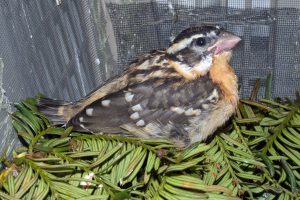Support Us
Since 1979 more than 140,000 animals have been treated by Wildlife Rescue.
Thanks to the support of individuals like you, Wildlife Rescue can provide a lifeline for animals in distress.
Like many other birds, Black-headed Grosbeak breed in British Columbia and then migrate south to warmer climates. The Black-headed Grosbeak male are easily identifiable by their orange breasts, blackheads, and black and white wings. Females have brown heads and orange and brown breasts. Both males and females have large bills that assist them in gleaning foliage and assembling nests.
The diet of the Black-headed Grosbeak consists of chickweed and pigweed, grains (including wheat and oats) and fruits (such as juneberries and elderberries) but predominantly they eat insects. In fact, around 60% of their diet includes insects (mainly beetles), spiders, and other animals. While grosbeaks may be different from other birds in diet, their nests tend to be quite similar. Female grosbeaks construct their nests in 3 to 4 days by gathering twigs, stems and pine needles and loosely weaving them together (so there is ventilation), and then lining this nest with hair, stems, and roots.

Accidental fall for a nestling!
Recently, a nestling grosbeak was rescued after a finder watched him fall from his nest prematurely with no parents nearby. The nestling was rushed to Wildlife Rescue hospital where a health check determined dehydration, feather issues, and poor natural development (which may have been the reason the parents abandoned him). Wildlife Rescue will raise the young until it is ready to navigate in the wild. Staff and volunteers are providing a protein-rich diet of insects and seeds along with nutritional supplements to help with weight gain and rehydration.
Over the last few days, the little nestling is responding to treatment and digesting its food and showing healthy feather growth.
Challenges They Face
Black-headed Grosbeaks face many challenges in the wild. As our summers become drier and drier, the threat of wildfires rises – leading to a loss of habitats and food for thousands of wildlife. As well, when trees fall, they often bring nests with them – and many nestlings do not survive. When healthy trees are chopped down, the soil is disrupted – which can lead to other trees falling, bringing deadly consequences as we saw recently with the heron rookery in Tsawwassen.
How to help these sweet birds?
Together we can help vulnerable nestlings survive and provide opportunities to flourish and thrive in the wild.
Of course, we can all do our part to help injured Black-headed Grosbeaks. If you see a bird that has exposed bone or blood, bugs or insects covering it, no feathers, or a bird that is sleeping, human intervention is required. Please contact our Support Centre for assistance. Donating to Wildlife Rescue is another easy way to help – we provide rehabilitation to 5,000 animals a year with unique care for each one of them. Learn more about donating here.